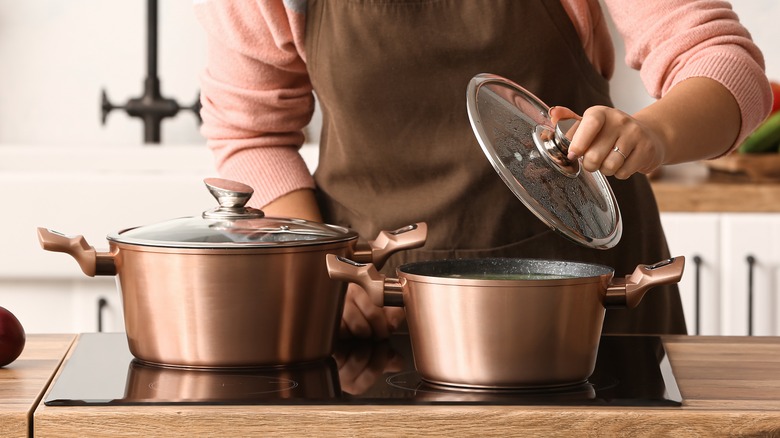Stay Away From Lids For These 3 Common Cooking Methods
To cover or not to cover? That is the question. A well-fitting stock pot lid is crucial to cooking ingredients like rice, or boiling water for pasta. Putting a lid on a pot keeps two things inside — heat and moisture, as explained by Martha Stewart. If you need to boil water or blanch vegetables, a covered pot will prevent heat from escaping and may result in a slightly faster boil, according to Cook's Illustrated. Any cook who has dropped pasta into a boiling pot of water knows the water needs to come to a boil again, per The Baltimore Sun. Naturally, we put the lid back on. A covered pot also creates steam by keeping moisture inside, which is needed for low-heat cooking like braising meat and simmering grains, per Martha Stewart.
But not all dishes want to be cooked under a protective covering. Some want to let out all their steam and cook in the open air. Here are three cooking methods where a lid is not always necessary.
Simmering sauces
The Merriam-Webster dictionary defines simmering as, "to cook slowly in a liquid just before the boiling point". When simmering grains like rice or quinoa, the moisture softens the grain slowly. Leaving the pot covered in this instance is important, otherwise, the water would evaporate before the grain is cooked, per The Kitchn. However, when simmering sauces or stews for thickening, air is what's needed.
Boss the Kitchen explains that keeping the lid off while simmering allows heat and moisture to escape, which thickens the sauce. This is true for gravy, stew, soup, and sautéing sauces. Not only are the simmering ingredients being thickened, but the flavors are also being concentrated, which is ideal for reductions. If you're worried about too much reduction or losing too much moisture, a lid-off technique allows you to see how much moisture has dissipated. Home Cook World says that the original level of moisture can be viewed on the side of the pan. Pop the lid back on when you feel it's thickened enough.
Pan-frying
Frying and moisture really do not like each other. Keeping a lid on a heating pan or pot traps moisture and steam, and that's not what you want if you're trying to get a crispy coating on fried foods, explains Home Cook World. High heat is crucial to frying, and moisture is another enemy to that.
Pan-frying is described as a "dry-heat" cooking method. This is when heat is transferred to food without moisture. By its very description, liquid is not a part of the scenario, according to Spruce Eats. When food hits the hot oil, steam is actually escaping from the food which is what makes that sizzling sound (via Decoding Delicious). That steam needs to evaporate, not go back into the pan. MSN goes so far as to say "never" cover food that you are frying. Keeping the lid off allows the crust to stay crisp while leaving the lid on means a soggy and sodden meal.
Searing
Searing, like frying, relies on high heat. When seared properly, a steak or pork loin should get a caramelized crust that's packed with flavor, according to Martha Stewart. Steaks need to be dried off thoroughly before being put into a hot pan or they won't sear, explains Epicurious.
If moisture in meat can prevent a good sear, then moisture dripping from a lid will do the same. Serious Eats says any excess moisture on the meat will leave your steak dry and stringy. They further explain that searing purposefully cooks the outside of a piece of meat while leaving the inside raw or only slightly cooked, which is why you sear tuna and steak. A lid would keep heat and moisture inside, insulating food and letting its internal temperature rise until it is cooked through, which is ideal for braising, via Food Network. To get a perfect sear, however, keep that lid off!
While a tight-fitting lid that's included with the purchase of a frying pan is nice, you can leave it off when using it for these three methods.



